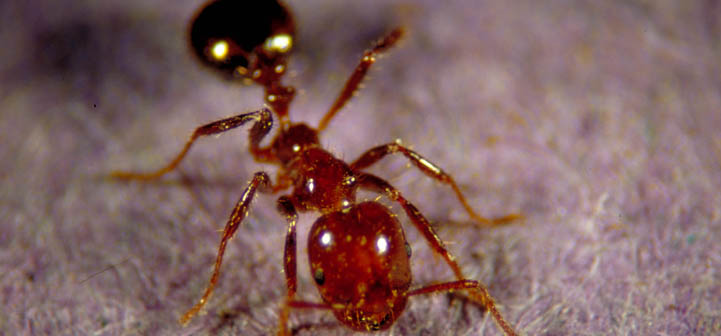FA Youth Home > List of Exercises > My Island Home
Activity: My Island Home
Hands-on Exercise: Learning about fire ant habitats
PLEASE READ SAFETY TIPS LOCATED AT THE BOTTOM OF THIS PAGE FIRST!
Overview
Observe ants in an island habitat, symbolic of their natural habitat.
Objective
Learn the requirements necessary for a habitat to be suitable for fire ants.
Materials
- Large bowl
- Water
- Floral foam or dense sponge
- Scissors
Instructions
- For this activity, you will need to be able to go outside to find live ants.
- Carefully cut a piece of floral foam or dense sponge to fit into the bowl (ask an adult to help you if needed).
- Cut the foam (or sponge) small enough so that it does not touch the sides of the bowl.
- Pour water into the bowl, 2 to 3 inches deep. Wait about 15 minutes for the water to be absorbed.
- While you are waiting, find an ant (or two) for your island. Where are going to look? Under a log or in a field might be a good place to start. Use a stick to transport the ant to the “island” or make an aspirator to move the ants from place to place.
- You’ll need to supply the ant with food. What kind of food could you place on the island?
- You could also place some broken sticks into the foam, providing the ant with something to climb on in this artificial habitat you have created.
- Keep the water level at 2 to 3 inches deep to maintain the “island” effect. Observe the ant(s) and its activities.
Wrap-up
- Describe how this habitat is different from a natural habitat where ants are typically found.
Safety Tips
- Use extreme caution when dealing with fire ants. If you know you are allergic to fire ants, do not do this exercise.
- First aid for fire ant stings: Commercially available sting medications will help. Washing stings with soap and water will clean the area and help reduce the chances of secondary infection. Some individuals may experience allergic reactions to the bites. Refer to the Medical Problems and Treatment Considerations for the Red Imported Fire Ant (ENTO-005) for more information on medical issues.
- If you are stung, do not scratch the sting or rupture the pustule that might occur at the sting site because secondary infections may occur. The pustule is a normal result of a fire ant sting and is sterile unless ruptured.
Additional Information for Instructors
-
You may want to refer to the original KIDzANTS Teacher Manual, which was included in the original release of the KIDzANTS Red Imported Fire Ant Youth module developed by the Texas A&M AgriLife Extension Service.
| << Previous: Where in the World? | List of Exercises | >> Next Exercise: What’s Buggin’ You? |
